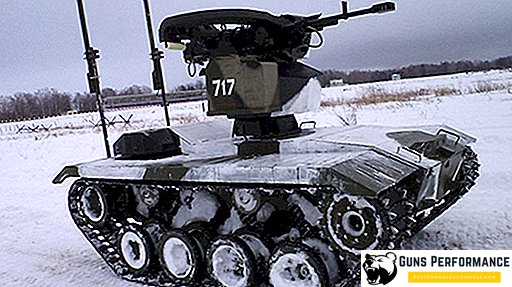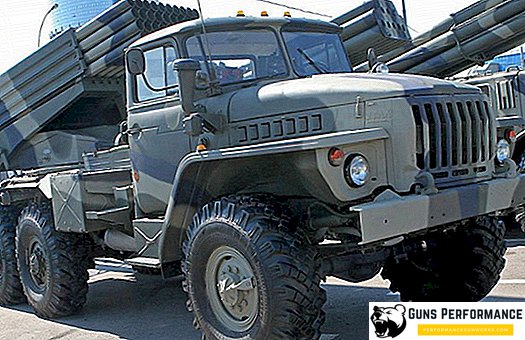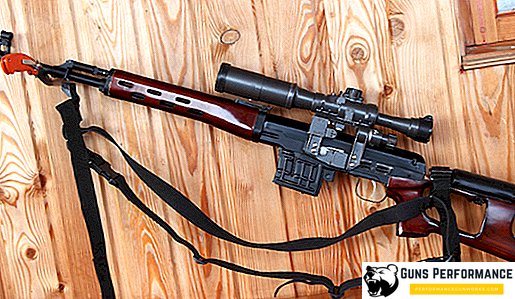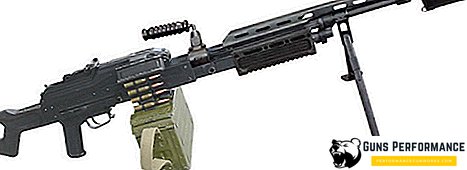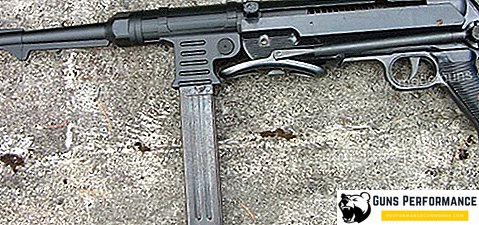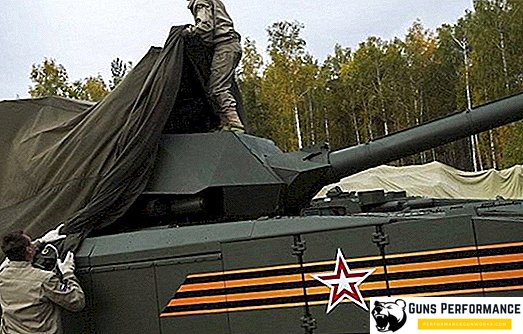The American T 34 is a heavy tank developed in the USA in 1945. It is an upgrade of the T-30 tank. The history of this model began when the US military decided to equip one of the prototypes of the T-29 with a 120 mm cannon used in the model T 53. The resulting hybrid was given the designation T 34, but later, after the end of the Second World War, work on modernization was extremely slow. As a result, the prototype of the T 34 was never released.

The history of the creation of the American tank T-34
According to the decision of the Artillery Department of the USA, in the same year of 1945, the T 30 modification tanks were supplemented with a 120 mm cannon from the T 53, as it was supposed at the beginning, the prototype would have been the T 29. , and the sub-caliber projectile, 1300 m / s, which made it possible to bypass the 105mm T5E1 (T29) and 155mm T7 by the impenetrability of the superpower. The gun also had a high rate of fire, namely 4 shots per minute, had armor penetration of 198 millimeters armor-piercing projectile on a homogeneous armor at an angle of 30 degrees. from the vertical at a distance of 914 meters (for comparison, the rate of armor penetration for armor-piercing projectiles D-25T under similar conditions is 140 mm) and 381 millimeters of sub-caliber on homogeneous armor at an angle of 30 degrees. from the vertical. In addition, if the armor-piercing projectile hit the anvil, the armor penetration would be 258 mm, and if it was a piercing projectile, the armor penetration could reach 512 mm. Such results can be considered incredibly high for the times of the Second World War.

The appearance of the new American T 34 practically did not differ from the prototypes T 29 and T 30. The only difference that could be noticed is a longer 120 mm barrel about 7.7 meters long in the new model. However, the increased weight of the T 34 forced the developers to add a counterweight to the back wall of the tower basket - 10.16 cm of armor.

120mm cannon
Tank gun T 52 120 mm had a separate charge. The striker in the T 34 was also placed as in the T 29, T 30, but the larger caliber baud was slightly modified. The mass of the test shot was 50 kg, the weight of the projectile was 23 kg. All ammunition was designed for 34 shots. The gun’s rate of fire was 5 rounds per minute. In addition, the gun was equipped with a telescopic sight T143E2 and periscopic M10E10. For firing from closed positions, the gun was equipped with an azimuth of T19, quadrant M9 and quadrant gunner M1. The only drawback of the new tank was the lack of stabilization of the gun.
Why the American tank T-34 did not receive mass production
After the end of hostilities, the T 34 development project was almost stopped. At this time, there was no question of acquiring a heavy tank, so the first thing they did was turn off the release of ammunition, and then the project itself.

Tests of the model at the Aberdeen proving ground revealed some problems, in particular, the problem of the tower’s gas contamination. After several shots, the concentration of toxic substances in the cabin reached a level dangerous for the life and health of crew members. However, even this was not the most serious problem. During the tests, a flashback was detected during the shot, which is why tankers who took part in the tests suffered and were hospitalized. The cause was unburned powder gases in the barrel, which were drawn into the cockpit and, mixing with oxygen, led to a flashback. In order to eliminate these phenomena, the designers have developed a system for purging the barrel with compressed air, but as a result, the desired result was not achieved. The compressor and the compressed air tank took up too much space in the reserved space.

Then the American developers have found another solution - installing a special device on the barrel that will pump smoke out. Previously, such a device was tested on models T15E4 and M3E4 with guns of 90 mm. The principle of construction was as follows: a cylindrical chamber was installed near the base of the barrel, holes were made in the barrel walls leading into the chamber. When the projectile left the barrel, the pressure in its channel quickly fell, while there was a high pressure in the chamber, which created a powerful thrust of gas through the ports for evacuation. The thrust was directed towards the cut of the trunk and removed the poisonous gases before the opening of the gate. Tests of this system, held at Fort Knox and Aberdeen showed a positive result - in the future, this smoke removal system became the standard for all tanks developed in the United States.

The end of the Second World War was the end for the American T 34. The military was no longer interested in the development of heavy tanks, including the T 29, T30 and T 32. The budget for the development and purchase of new machines was significantly reduced. However, it is worth noting that the main design solutions of the T 34 were used to develop later American tanks.
Technical characteristics of the American T-34
| Total information | ||
| crew | 6 people | |
| length with a gun forward | 11.0871 m | |
| the length of the gun on the camp | 10.11428m | |
| length without gun | 7.60984 m | |
| cannon departure | 4.16306m | |
| flap width | 3.80238 m | |
| height with commander tower | 3.22326 m | |
| rut: with 28-inch caterpillars with 23-inch caterpillars | 2.921 m2.794 m | |
| clearance | 0.47752m | |
| line of fire height | about 2.159 m | |
| shoulder strap | 2.032 m | |
| weight, combat | 65.1358643 kg | |
| weight, empty | 61.053533 kg | |
| power density: normal to the greatest | 9.8 hp / ton 11.3 hp / ton | |
| ground pressure: with 28-inch caterpillars with 23-inch caterpillars | 12.4 inches / sq. inch15.1 inch / sq. inch | |
| Armor | |||||
| armor | forehead | board | stern | top | bottom |
| body | 70 mm> 58° | 76 mm> 0 ° (front) 51 mm> 0 ° (behind) | 19 mm> 62 ° | 38 mm> 90° | 25 mm> 90 ° (front); 13 mm> 90 ° (rear) |
| superstructure | 102 mm> 54° | 51 mm> 9 ° | - | ||
| tower | 178 mm> 0 ° | 127 mm> 0 ° | 203 mm> 0 ° | 38 mm> 90 ° | - |
| mask | 203 - 279 mm> 0 ° | ||||
| armor type | tower - cast homogeneous steel; body - rolled and cast homogeneous steel | compound | welding | ||
| the slope of the armor is calculated from the vertical | |||||
| Armament | ||
| 120 mm Gun E53 on the turret T125 | ||
| traverse | 360 ° electro-hydraulic and manual | |
| turret rotation speed (maximum) | 20 sec / 360 ° | |
| elevation | from + 15 ° to -10 ° | |
| rate of fire (maximum) | 5 shots per minute (with 2 loaders) | |
| loading | tame | |
| stabilization system | not | |
| (1) .50 caliber MG HB M2 - flexible anti-aircraft mount on the tower (2) .50 caliber MG HB M2 - twin (1) .30 caliber MG M1919A4 - heading | ||
| Ammunition | ||
| 34 shots for the 120mm gun | ||
| 2090 rounds for .50 caliber | ||
| 1080 ammo for .45 caliber | ||
| 2050 rounds for .30 caliber |
| Fire control system and surveillance devices | ||
| main armament | ||
| for direct shooting | telescopic sight Т143Е2 periscope sight М10Е10 | |
| for indirect shooting | pointer azimuth T19kvadrant vertical guidance M9kvadrant M1 gunner | |
| surveillance devices | ||
| straight lines | indirect | |
| driver | Luke | periscope M13 (1) |
| driver's assistant | Luke | periscope M13 (1) |
| commander | viewing blocks (6) in the commander's tower, sunroof | periscope M15 (1) |
| gunner | not | periscope М10Е10 (1) |
| left loader | Luke | not |
| right loader | manhole pistol loophole | not |
| Engine | ||
| manufacturer and model | Continental AV-1790-3 | |
| type of | 12 cylinders, 4-stroke, V-shaped 90 ° | |
| cooling | airy | |
| ignition | magneto | |
| volume | 1791.7 cubic inches | |
| piston | 5.75 x 5.75 inches | |
| unit pressure | 6.5:1 | |
| normal power (maximum) | 704 hp / 2800 rpm | |
| highest power (maximum) | 810 hp / 2800 rpm | |
| normal torque (highest) | 1,440 feet per pound / 2000 rpm | |
| the greatest rotational moment (the greatest) | 1,610 feet per pound / 2,200 rpm | |
| weight | 2332 pounds dry | |
| fuel | 80 octane gasoline, 320 halon | |
| motor oil | 72 quarts | |
| Power train | ||
| transmission | cross drive CD-850-1, 2 speeds forward, 1 back | |
| ratio | 12.7: 1 backward 6.2: 1 lower 20.6: 1 back | |
| steering | mechanical, steering lever type joystick, 5.7.ab. / min. | |
| brakes | disc | |
| main gear | spur gear, 6.31: 1 | |
| drive wheel | back, 15-teeth, diameter - 28.89 inches | |
| Chassis | ||
| suspension | torsion bar, 16 track rollers with individual suspension (8 per track) | |
| bandage size | 26 x 6 inches | |
| support rollers | 14 (7 per caterpillar) | |
| steering wheel | ahead on every caterpillar | |
| guide wheel size | 26 x 6 inches | |
| shock absorbers | on the first 3 and last 2 rinks on each side | |
| caterpillars* | T80E3 - two-ridge, 28 inches wide, rubber-metal T84E3 - two-ridge, 28 inches wide, with rubber chevron | |
| step | 6 inches | |
| total tracks | 204 (102 per track) | |
| track support length | 204.6 inches left 208.6 inches right | |
| * Caterpillars T80E3 and T84E3 are caterpillars T80E1 and T84E1 23 inches wide with 5-inch spurs | ||
| Electrical system | ||
| Rated voltage | 24 volts dc | |
| main generator | 28.5 volts, 200 amps, power take-off from the main engine | |
| auxiliary generator | 28.5 volts, 200 amps, powered by an auxiliary engine | |
| batteries | 2 pieces, 12 volts | |
| Means of communication | ||
| radio | SCR 508 or 528 in the tower basket | |
| interphone | 6 stations and external additional output RC-298 | |
| Fire protection system | ||
| 3 stationary 10-pound fire extinguishers with carbon monoxide2 separate 5-pound fire extinguishers with carbon monoxide |
| Driving performance | ||
| highest speed | 22 miles / hour on the highway | |
| pulling force | 91.700 pounds64% of the weight of the machine | |
| incline | 60% | |
| ditch | 6.25 feet | |
| wall | 26 inches | |
| ford | 42 inches | |
| smallest turning diameter | around its axis | |
| power reserve | about 100 miles of highway | |
Heavy Tank T34 in video games
T34 was not put into service and did not participate in hostilities, but it is actively used on the battlefield of tank video games. He was present as a heavy tank of level 9, later transferred to level 8 as a premium tank.


